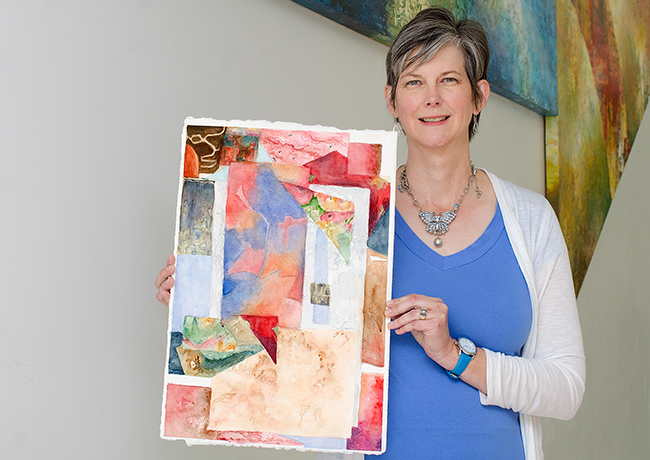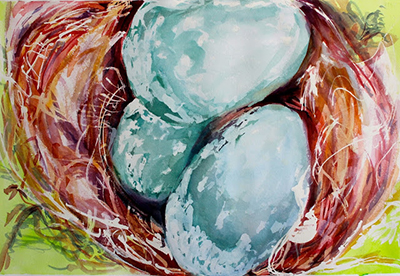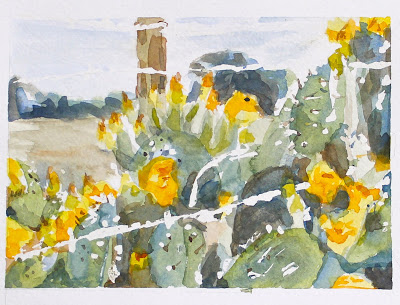Senior Draws Upon Experience In 'Viewing' Effects Of Art On Healing
Oct. 24, 2014
SHSU Media Contact: Aubrie Walker
 |
| Senior Laurie Grawl has taken a "non-traditional" route to college; In doing so returning to school more than three decades after she began her degree, she serendipitously found a research interest that allows her to combine her major and her personal experience. Above, she displays her watercolor work "Whole Again," inspired by an article in an art magazine on H.C. Dodd's method. —Photo by Brian Blalock |
When Sam Houston State University senior art major Laurie Grawl was 37 years old, she suffered a massive heart attack, resulting in damage to 40 percent of her lower heart.
After seven years of battling what she learned was a genetic mutation disorder; being in and out of different hospitals and doctors’ offices; and going through test after test, Grawl received the news she had long awaited—her cardiologist confirmed that she was completely healed.
“I was very disabled with the damage done to my heart, but with many prayers—and for whatever reasons—God reversed everything,” Grawl said. “My doctor at Memorial Hermann Hospital did a test and discovered that the three arteries that were torn originally were reformed and the one that held on was still functioning.
“You could still see the damage done on my heart from the heart attack, but the infraction rate was like someone who had never had a heart attack,” she said.
Sixteen years later, Grawl has turned those life-changing experiences into opportunities that began developing as a child.
Throughout Grawl’s life, she has always pursued her love for art. At a young age, she began to draw and paint, giving her prized pieces to her mother for safekeeping.
“Growing up in a artistic family, I was always around and encouraged to do art,” Grawl said. “It was just the natural thing to do.”
When it came time to go to college after graduating from high school in 1978, Grawl went to the University of Houston in hopes of getting an art degree, but along the way, she decided she wanted to start up her own business and marry the man of her dreams, so she stepped away from being a student and began using her artistic talents through other mediums.
She became an independent business owner of an interior design company called Laurie's Creative Decors. She also was a radio talk host for a while, as well a writer for the Navasota Examiner.
Grawl raised two girls with her husband, Ed, and homeschooled her youngest daughter from sixth through 12th grade.
“I had my own business before I had children and stayed at home for 26 years,” Grawl said. “I did artistic endeavors and did not think much about finalizing my art degree.”
But once she was confronted with health problems and had been released on a bill of good health, she decided it was time to finish what she had started 34 years before.
Grawl's Gallery |
 |
 |
 |
 |
| Some of Grawl's art has been inspired by her research on the healing properties of art. Pieces include (from top, down) "Nesting Instincts," a watercolor painting; "A New Song," a white porcelain glaze with sepia decals; "A Prickly Situation," a watercolor painting; "Monet My Way," opaque glazed ceramic on stained wood. To see more of Grawl’s art, visit lgrawl.com. |
So in spring 2012, Grawl found herself on the Sam Houston State University campus as a freshman art major.
“Coming back to school, I wasn’t really quite sure where it was going to lead me,” Grawl said, “but with all my credits from 34 years ago transferring from UH, I knew I was suppose to come back to college.”
During her second semester, she took a class called “Principles of Sociology” with Olena Leipnik, who assigned an optional extra credit project that asked students to write a paper answering the question, “If you were to propose a research project, what would it be?”
Previously, through Grawl’s SHSU campus art-curating job, she heard that Mt. Sinai Hospital on the Pacific Coast had an art program where they employed a full-time art curator.
The reasoning behind the program was the observation and belief that art helps patients heal.
Grawl, having first-hand experience in and out of hospitals, felt there was something to this, so when reading on the topic for the extra credit assignment, she decided this was her chance to find out more on the healing aspects of art.
“I went to her and proposed doing some type of research on how art in hospitals helps the healing process, because the hospitals where I went were lacking in art,” Grawl said.
As weeks went on, Grawl began researching other individuals who had touched on the same subject, she found that Roger Ulrich, a professor of architecture at Texas A&M University, had expanded the idea of art helping patients heal more quickly to even the buildings interior design encouraging the healing process. She also discovered that the University of Washington Hospital, which earlier in her illness had conducted testing on her disorder, also had a full-time art curator, artist in residence, and self-guided gallery for patients and their families.
Inspired, Grawl decided to dig further and think about how art is displayed and what emotions or problems could be caused by ill placement.
“It isn’t actually the making of the art but the observation of it—it gets patients out of their room and their families talking about something other than treatments,” Grawl said. “A lot of times, you find yourself in a strange environment where you can’t even gage what time of the day it is. You feel very disconnected from the outside world—seasons change and your children grow.”
She found that having art displayed gives patients and their families a more “home-like” feel and focuses their minds on something beautiful, rather than plain white walls.
The challenges of where, when and what kind of art is appropriate in a certain areas are a big part of Grawl’s research.
“We do know that you do have to be careful in having different kinds of artwork for patients; you cannot have certain artwork around mentally ill, as opposed to someone who has cancer or a heart condition,” Grawl said. “If we orient art differently, people react to it differently.
“What I tried to do was to find out what type of art is correct in correlation to the stages of diagnosis and treatment of a patient,” she said. "
As part of her ongoing research, Grawl and Leipnick have begun an observation part of the project, where they can observe different patients’ reactions to different types and arrangement of art.
“I could not do this without Leipnik,” Grawl said. “She keeps me going and steering me in the way I need to go with this project.”
“It is certainly something that could improve the quality of lives of many people,” said Leipnik, a lecturer in the sociology department. “It’s even more important in the situation where people are often frustrated and somewhat lost and need all the support that others can provide.
“Creating a supporting environment in facilities intended for medical treatment means assisting those under treatment to discover additional resources for recovering,” she said. “At a certain moment, this might be of a critical importance to somebody.”
Grawl has gone through several changes in this process, herself, even in the way she looks and makes her own art.
“As I saw how important it was in my life and how it facilitated healing, my interest as a long-term patient with art is to bring hope, encouragement and joy in other situations, that understanding is what God has gifted me in,” Grawl said.
Grawl and Leipnik are not finished with their research, but they are steadily moving forward.
- END -
This page maintained by SHSU's Communications Office
Associate Director: Julia May
Manager: Jennifer Gauntt
Located in the 115 Administration Building
Telephone: 936.294.1836; Fax: 936.294.1834
Please send comments, corrections, news tips to Today@Sam.edu.

 SamWeb
SamWeb My Sam
My Sam E-mail
E-mail

